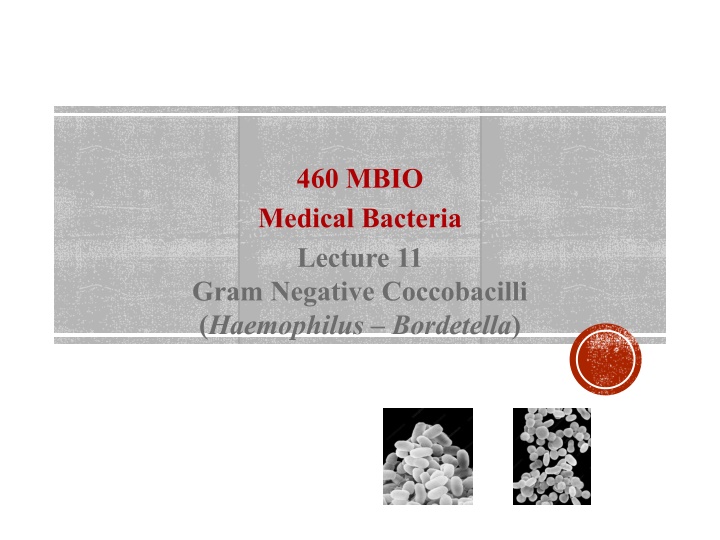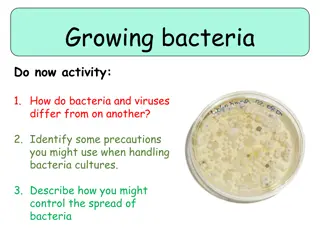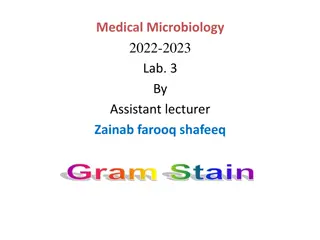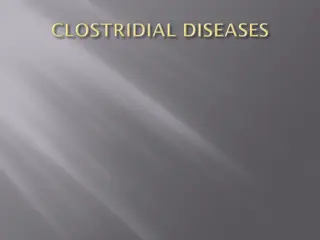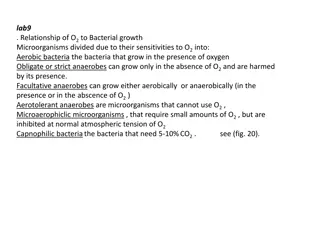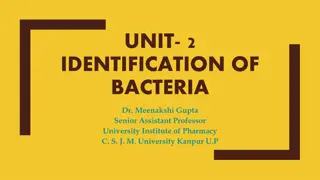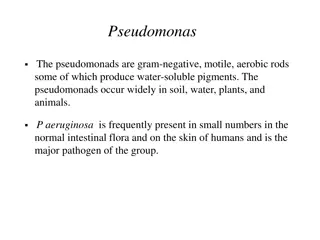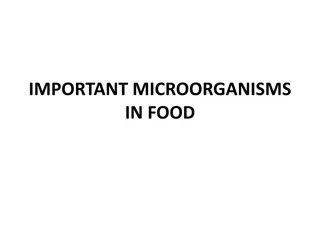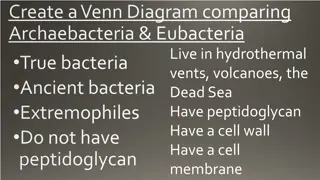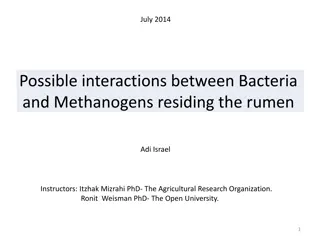460 MBIO Medical Bacteria Lecture
Haemophilus is present in the upper respiratory tract as normal flora, with species such as H. influenzae and H. parainfluenzae. They are small gram-negative coccobacilli requiring enriched media for growth. Haemophilus causes diseases like acute meningitis and pneumonia. Bordetella pertussis, causing whooping cough, is a very small gram-negative coccobacillus spread through respiratory secretions. Laboratory diagnosis involves specialized agar culture. Virulence factors include capsules, toxins, and adhesins.
Download Presentation

Please find below an Image/Link to download the presentation.
The content on the website is provided AS IS for your information and personal use only. It may not be sold, licensed, or shared on other websites without obtaining consent from the author.If you encounter any issues during the download, it is possible that the publisher has removed the file from their server.
You are allowed to download the files provided on this website for personal or commercial use, subject to the condition that they are used lawfully. All files are the property of their respective owners.
The content on the website is provided AS IS for your information and personal use only. It may not be sold, licensed, or shared on other websites without obtaining consent from the author.
E N D
Presentation Transcript
460 MBIO Medical Bacteria Lecture 11 Gram Negative Coccobacilli (Haemophilus Bordetella)
Haemophilus General Characteristics Present in upper respiratory tract as a normal flora in healthy people. Medical importance species: H. Influenzae H. parainfluenzae H. ducreyi Morphology Small gram-negative coccobacilli Non-spore forming Non-motile some strain are capsulated Culture character aerobic and anaerobic growth. Growth is enhanced in CO2. Fastidious. Require enriched media for growth. Requiring growth factors present in blood for isolation. The growth factors are: X-factor (Hemin). V-factor (Nicotinamide- adenine dinucleotide) (NAD). Grown on chocolate blood agar (X and V factors released from the RBCs). Requirement for growth factor helps for differentiate the species Require X and V Require v Require x * H. influenzae * H. parainfluenzae * H. ducreyi 1
Disease: Extracellular pathogen (not invade into the cells). It is an important secondary invader to the influenza virus. causes disease commonly in young children (Acute pyogenic meningitis- Acute epiglottitis Pneumonia- Otitis media- Sinusitis- Cellulitis) Encapsulated strains of H. influenzae isolated from CSF cerebrospinal fluid are coccobacilli similar in morphology to Bordetella pertussis, the agent of whooping cough. Non encapsulated strains are less invasive, but they are able to induce an inflammatory response that causes disease. Laboratory diagnosis: Grows on chocolate agar but not on blood agar (blood agar contains factor X but insufficient factor V. Heat treatment of blood before incorporation in agar produces a medium known as chocolate agar , which contains both factors for H. influenzae to grow). Serotyping by agglutination tests can be carried out on capsulated strains. 2
Virulence Factors Polyribosylribitol phosphate (PRP) capsule : most important virulence factor, resistant to phagocytosis. M-protein IgA protease Fimbriae; increase the adherence to respiratory cells Endotoxins No produce exotoxins . 3
Bordetella pertussis General Characteristics Morphology Very small gram-negative coccobacillus that appears singly or in pairs. Non motile Culture character Strictly aerobic Fastidious ( blood agar and other additives) Disease: Whooping cough (pertussis) Airborne disease, spread through respiratory system secretions. Highly contagious Whooping cough is a relatively mild disease in adults but has a significant mortality rate in infants. 4
Laboratory diagnosis: Culture on specialized agar, e.g. Bordet Gengou (charcoal blood agar). Colonies may take 2 3 days to grow. Virulence Factors cytotoxins haemolysins. filamentous hemagglutinin ( adhesins). Pertussis toxin, PTx: (a major component of acellular pertussis vaccine) Endotoxin Prevention: DPT vaccines. 5
